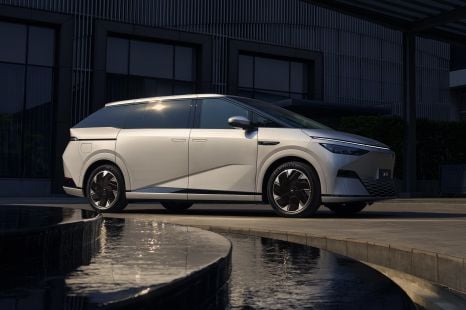

William Stopford
Will 2026 be the year of the people mover in Australia? China seems to think so
4 Hours Ago
The Honda CR-V and Hyundai Tucson are two of Australia's longest-running and most popular mid-sized SUV nameplates. We pit them head-to-head.

News Editor
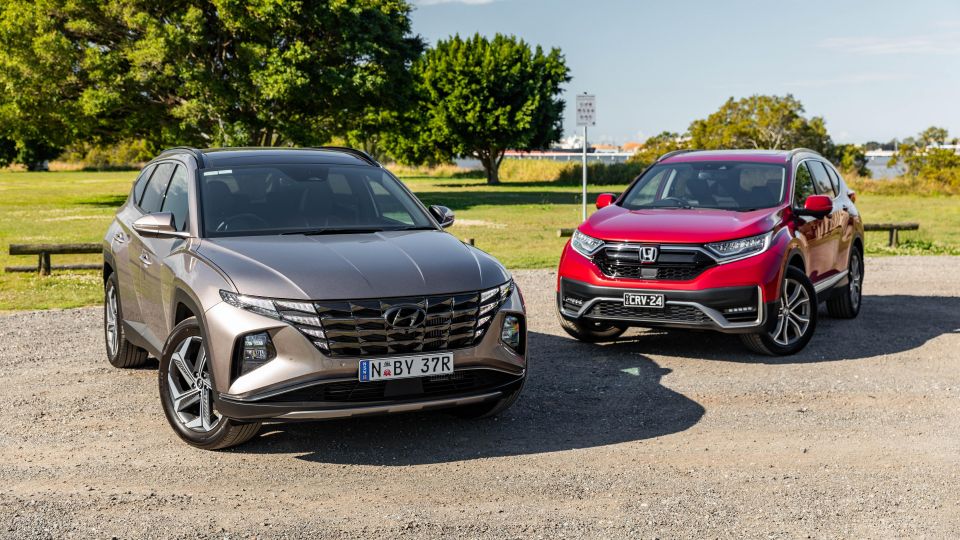

News Editor
The mid-sized SUV segment is Australia’s best-selling, and that should come as no surprise. As the mid-sized passenger car segment has evaporated and the big Australian-made cars have disappeared, they seem the natural successor to both.
In most mid-sized SUVs you’ll get a combination of manageable exterior dimensions, a comfortable interior, and decent fuel economy that makes these so popular with Australian families.
The Honda CR-V is one of the oldest nameplates in this segment, having first launched in Australia in 1997, while the Hyundai Tucson first appeared here in 2004.

We’re now up to the fifth generation of CR-V and the fourth of the Tucson, with the former receiving a facelift in 2020 and the latter receiving a total redesign this year.
These are two of the better-selling SUVs in their segment, not quite reaching the levels of the Mazda CX-5 and Toyota RAV4 juggernauts but holding their own against the likes of the Kia Sportage, Mitsubishi Outlander, Nissan X-Trail and Subaru Forester.
We’ve pitted these two segment stalwarts head-to-head in highly-specified all-wheel drive guises.

Honda offers a wide range of CR-V models, with five front-wheel drive variants – two with a third row of seating – and two five-seat all-wheel drive variants. All bar the base Vi feature a turbocharged 1.5-litre four-cylinder engine.
Our VTi-LX AWD tester sits at the very top of the range. As part of a switch to an ‘agency’ sales model, where Honda owns its stock, its entire range has fixed nationwide drive-away pricing. The VTi-LX is priced at $53,200 drive-away including metallic paint.
Hyundai’s Tucson range is a little more complicated. There are three four-cylinder engines on offer: a naturally-aspirated 2.0-litre with front-wheel drive, and 1.6-litre turbo-petrol and 2.0-litre turbo-diesel engines with all-wheel drive.
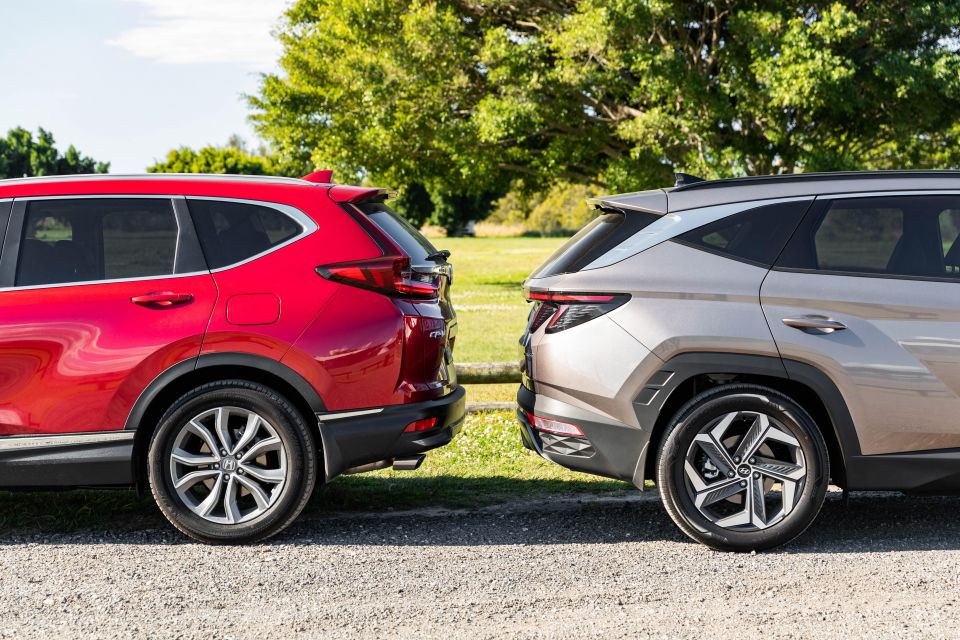
The company offers the Tucson in three core trim levels – base, Elite, and as-tested Highlander – but is also introducing an optional N Line package on every variant. That means our tester, priced at $50,000 before on-roads, may be the top trim level but it isn’t the costliest Tucson.
You can add the N Line package for an extra $1000, while adding the diesel engine increases the price by another $1000.
With the $595 premium paint added, our Tucson came to $55,236 drive-away based on a Sydney postcode.
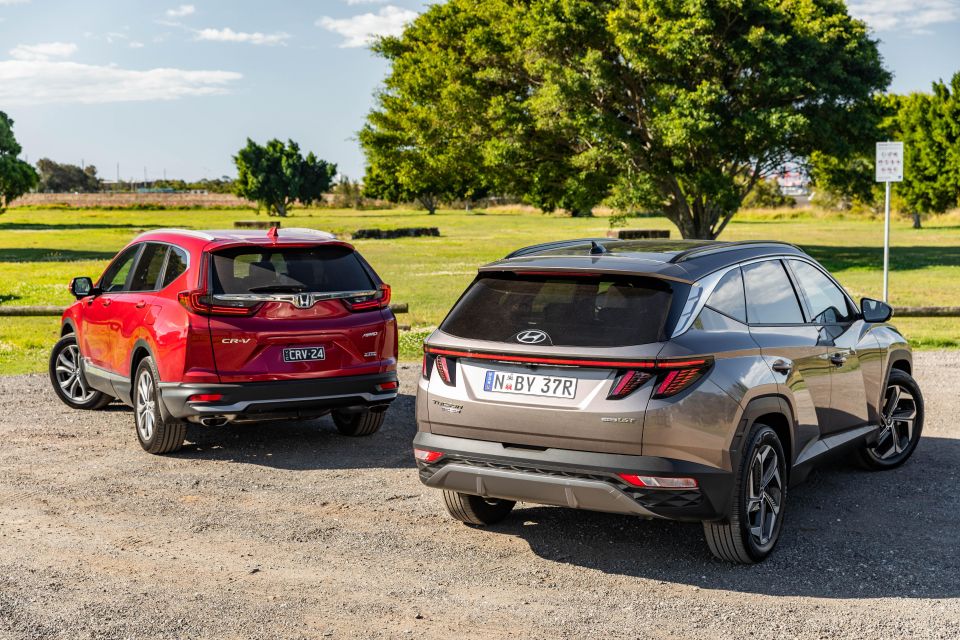
Standard features common to both vehicles include:
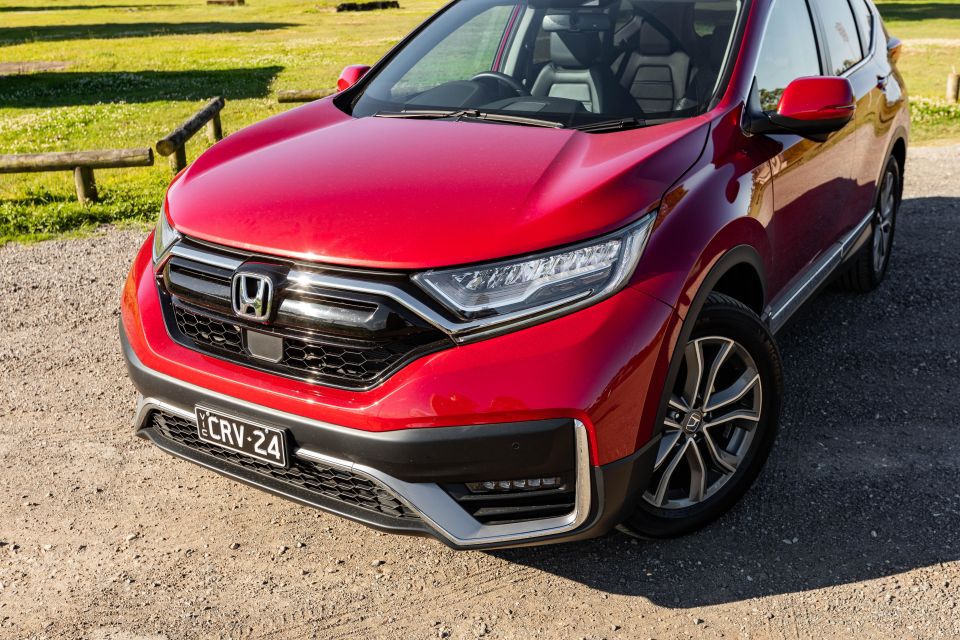
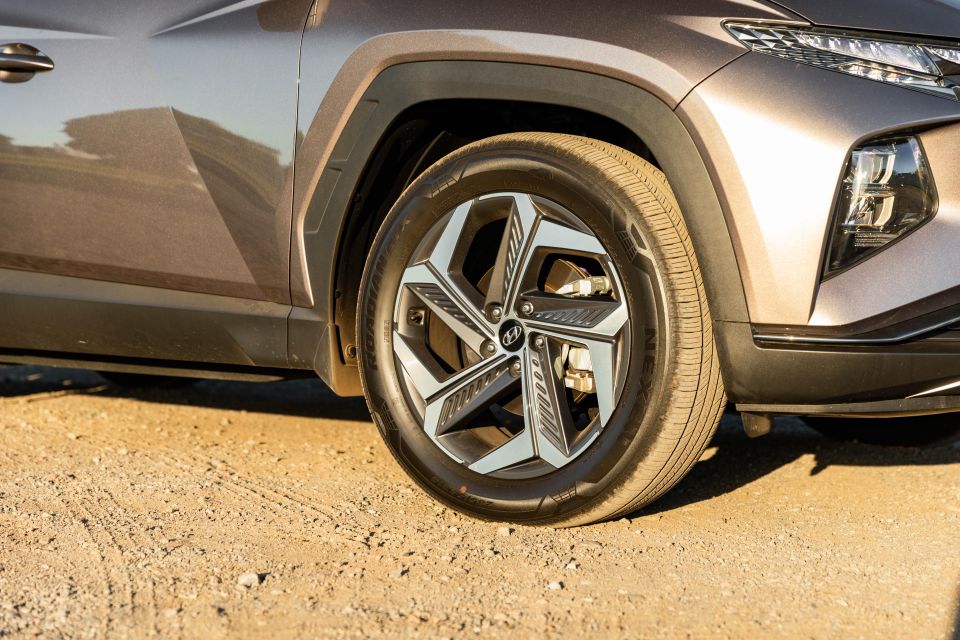
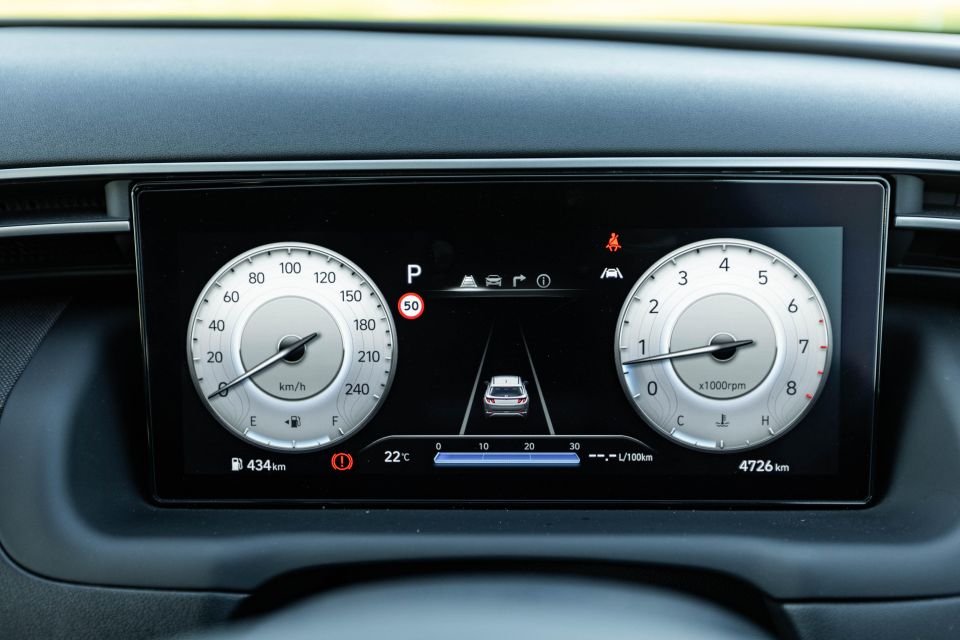

The Honda’s touchscreen measures 7.0 inches, while the Hyundai has a 10.25-inch unit. The Honda has an eight-way power driver’s seat and a four-way power passenger seat, while the Hyundai has 10-way and eight-way power front seats, respectively. Both feature memory for the driver’s seat.
The Hyundai alone gets:
While both models come standard with a black leather-appointed interior, the Hyundai alone offers a brown leather option. It costs an extra $295, while the optional N Line package adds sporty items like metal pedals, leather-and-suede upholstery, and front sports seats.
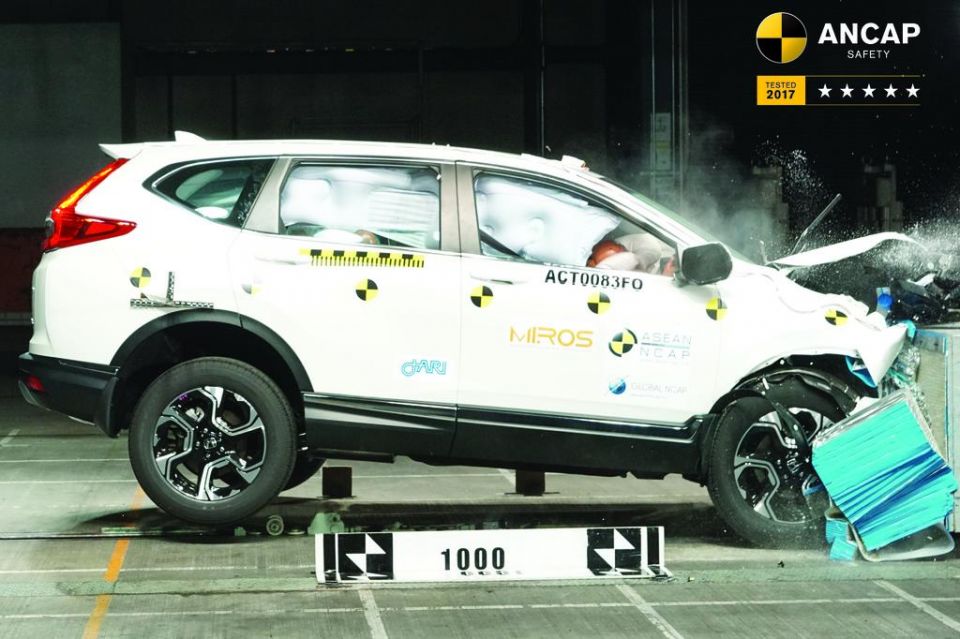
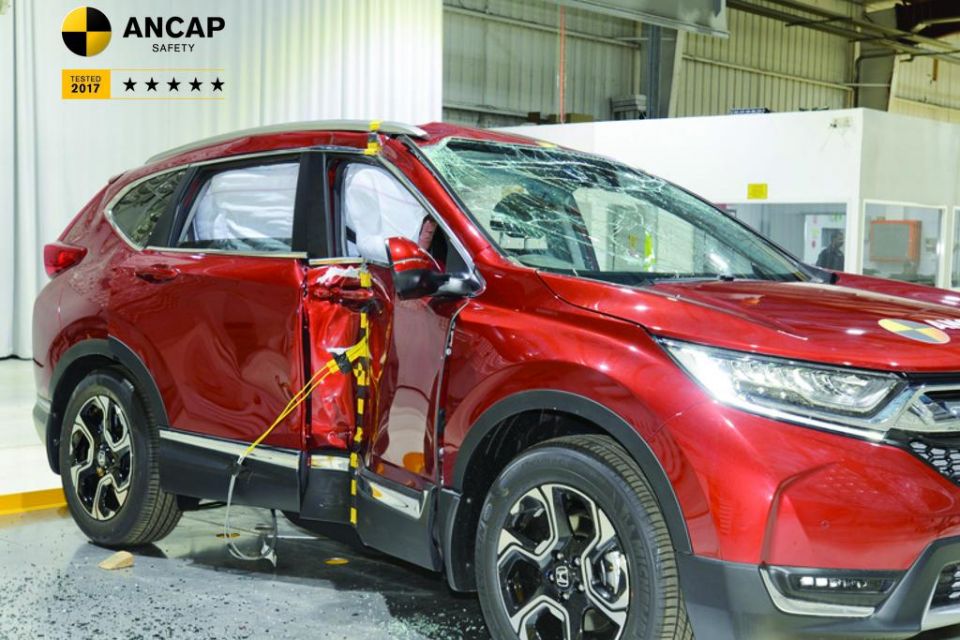
While the Tucson has some newer safety technology than the CR-V, it has yet to be tested by ANCAP. The CR-V, in contrast, has a five-star rating from the safety authority with a 2017 date stamp.
The CR-V and Tucson both come with autonomous emergency braking with pedestrian detection, though the Tucson includes cyclist detection plus a junction-turning feature.
The Honda has a form of blind-spot monitoring, but the Hyundai goes one step further and features both active blind-spot assist and rear cross-traffic assist which will not only alert you of a potential accident but actively help the car avoid it.
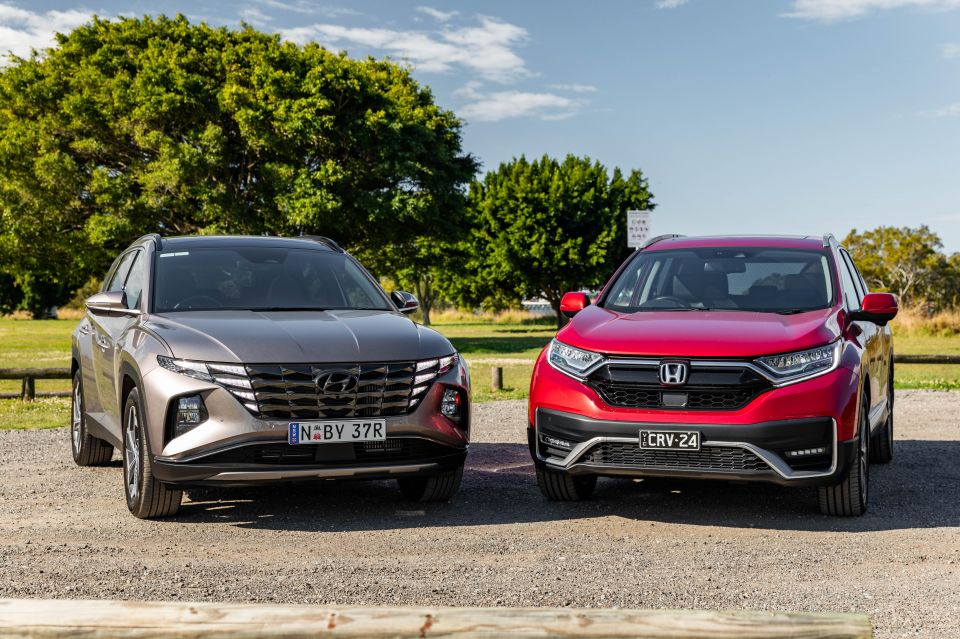
Both models feature two different lane assist systems. Each car has an automatically-activated system that provides a gentle nudge if you try to cross a road line, as well as a system you activate via a button on the steering wheel that more forcefully keeps you within your lane.
The CR-V features Honda’s LaneWatch blind-spot monitor, which projects footage of the left-hand side of your vehicle when you switch on the left indicator or press a button at the end of a stalk. I first remember seeing this system in action in a 2014 Accord Plug-In Hybrid I rented in the US, but alas it hasn’t changed much since then.
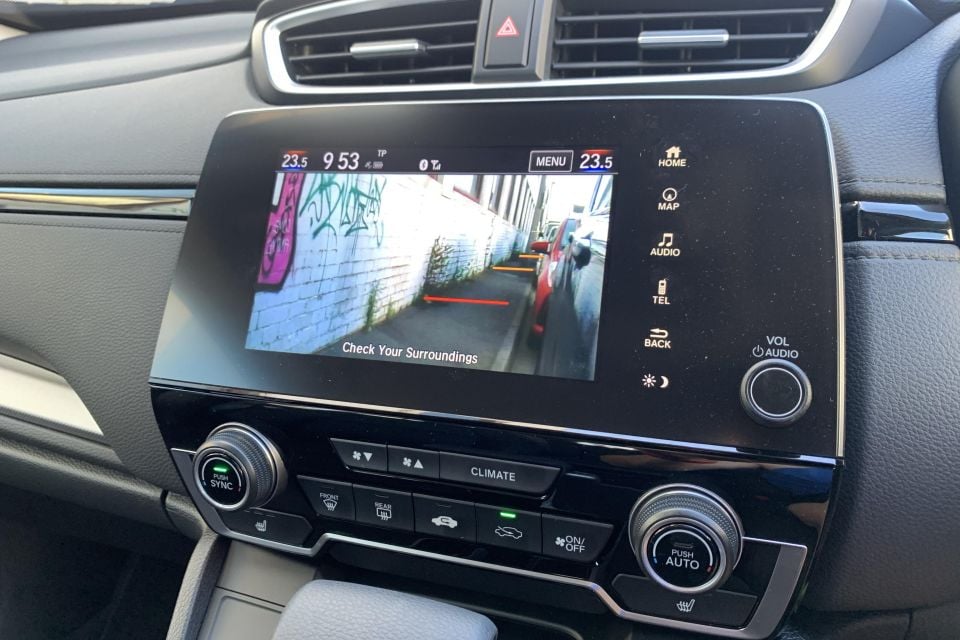
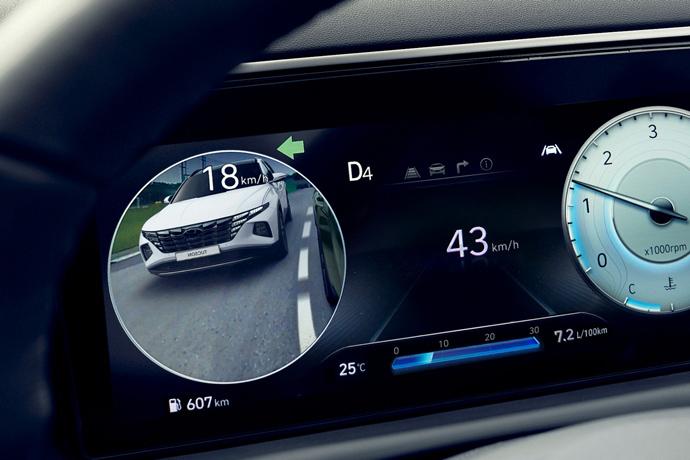
In the interim, Hyundai has taken the ball and run with it, introducing its Blind-Spot View Monitor. This projects footage in the digital instrument cluster of not only the left-hand side of the vehicle but also the right-hand side. While the image may be smaller, the execution looks more sophisticated and it means you don’t lose sight of what’s on the touchscreen while your indicator is on.
The Tucson also exclusively offers safe exit warning, a surround-view camera, rear parking collision avoidance, and leading vehicle departure alert, while both vehicles feature adaptive cruise control with stop/go.
Front, front-side and curtain airbags are standard on the Tucson and CR-V, with the Tucson also including a front-centre airbag to prevent occupants clashing against each other in a side impact.
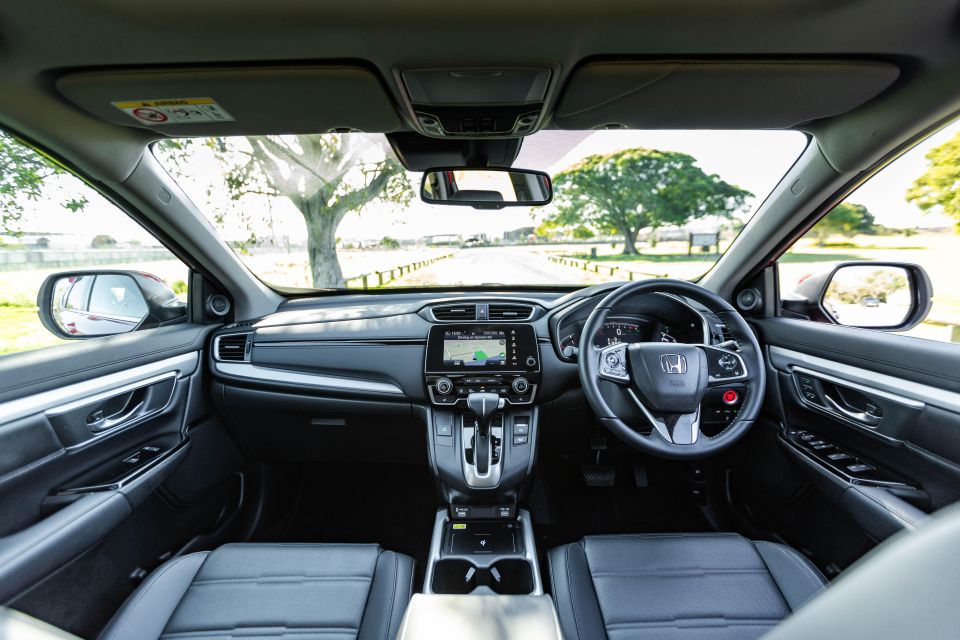
CR-V
The CR-V mightn’t have the flashiest interior but it’s comfortable and logically laid-out. It stacks up well against the outgoing Outlander and X-Trail interiors, though it falls short of newer fare like the Tucson.
There’s soft-touch material with attractive stitching details on the dashboard and doors, while the metal inserts actually look and feel like metal.
The shifter is located at the base of the centre stack, which juts out like a ledge. Honda has wisely put padded material on the side of this overhang to break up the plastic and give you something to rest your knee against.
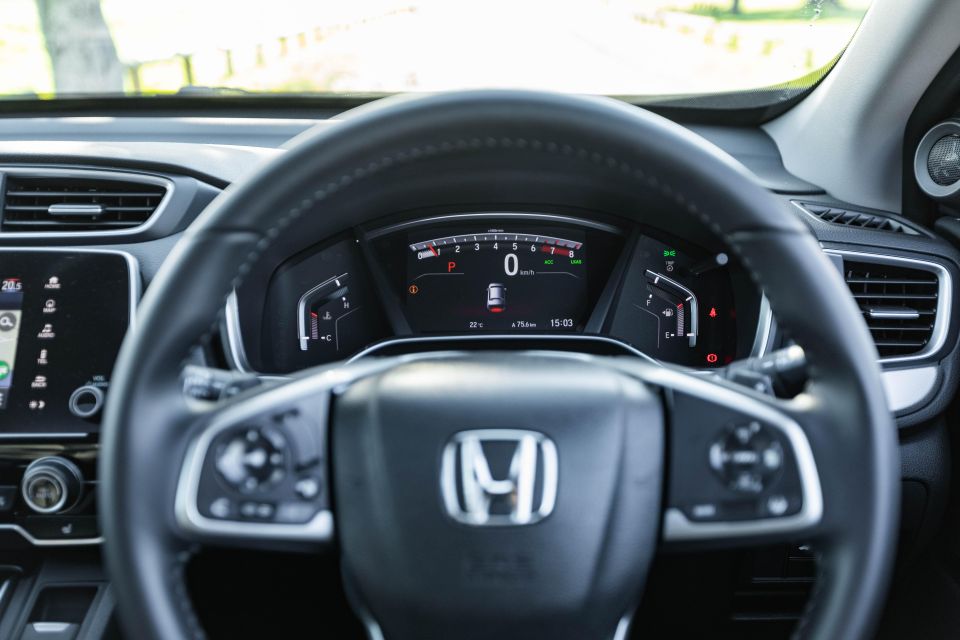
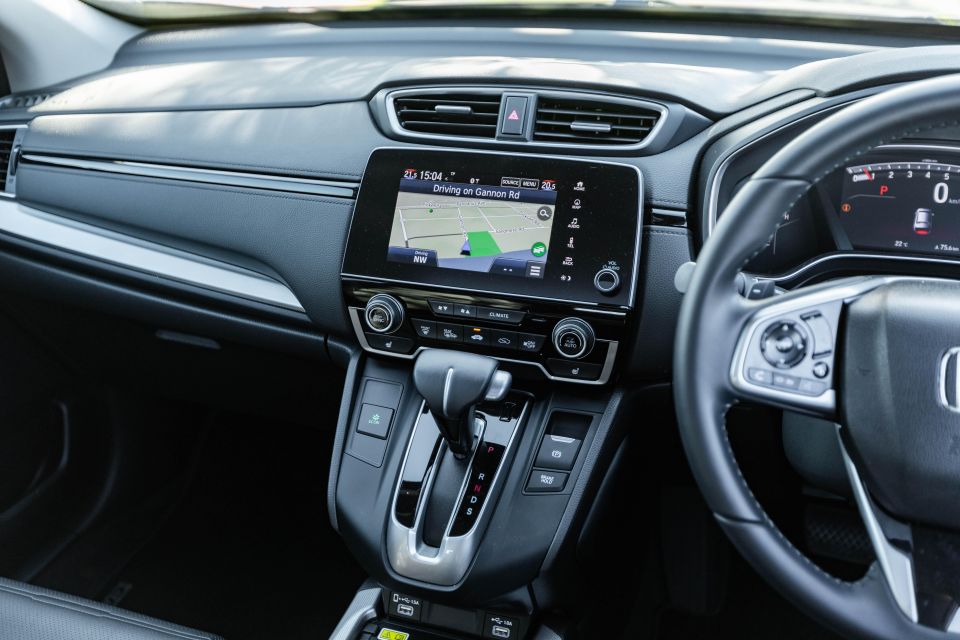
Where the CR-V most shows its age is in its infotainment system. It’s already on the small side of things in this segment, measuring just 7.0 inches. The screen’s loading times and graphics make it look decidedly old-hat, while the reversing camera footage is disappointingly low-resolution.
The instrument cluster isn’t as slick and modern as the Tucson’s, but it’s still predominantly digital and has a neat layout and clear graphics.
Moving down, the centre console is rather clever. There’s a sliding plastic tray that allows you to either have an enclosed centre console bin or open up what’s effectively a giant pit. It’s so voluminous, you can fit any number of items in here. It’s only let down by a lid that flexes a little, while we did hear a slight rattle at times.

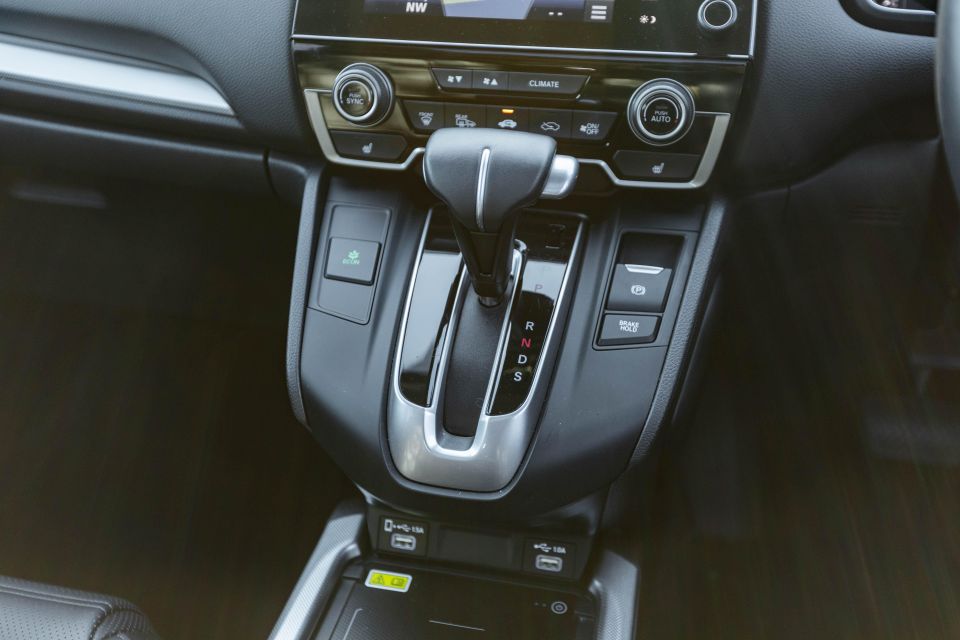
There are cupholders plus a 12V outlet in this gaping chasm, plus two USB-A outlets ahead of the wireless charging pad. The pad sits in the shadow of the ‘shifter ledge’, but it’s still easy to put your phone on it and see that it’s charging.
The rear doors open fully 90 degrees to a spacious, comfortable back seat with ample headroom, leg room and knee room. There are rear air vents, two USB-A outlets, plus openings in the doors that can fit both a large bottle and a can.

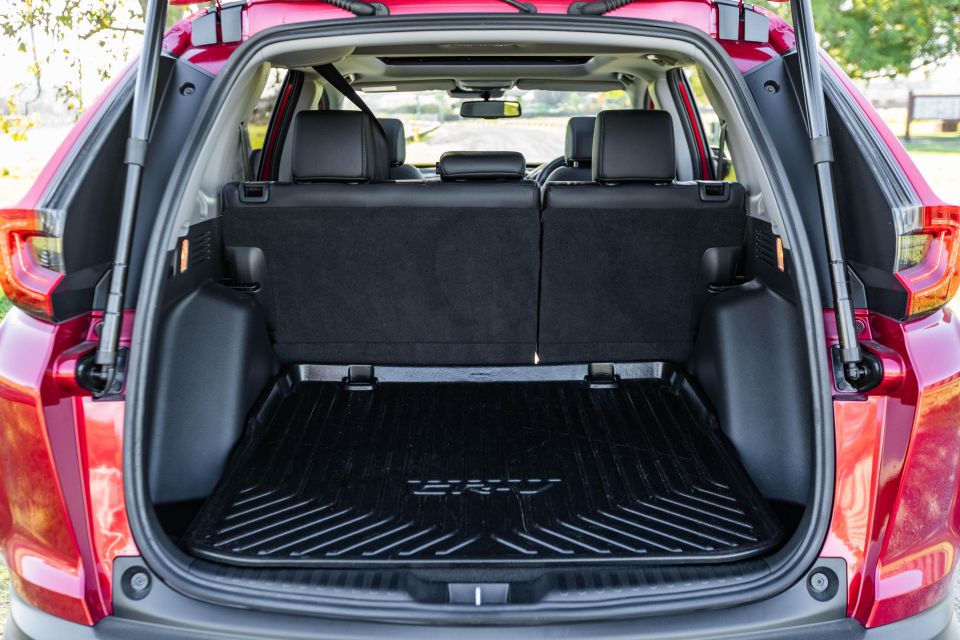
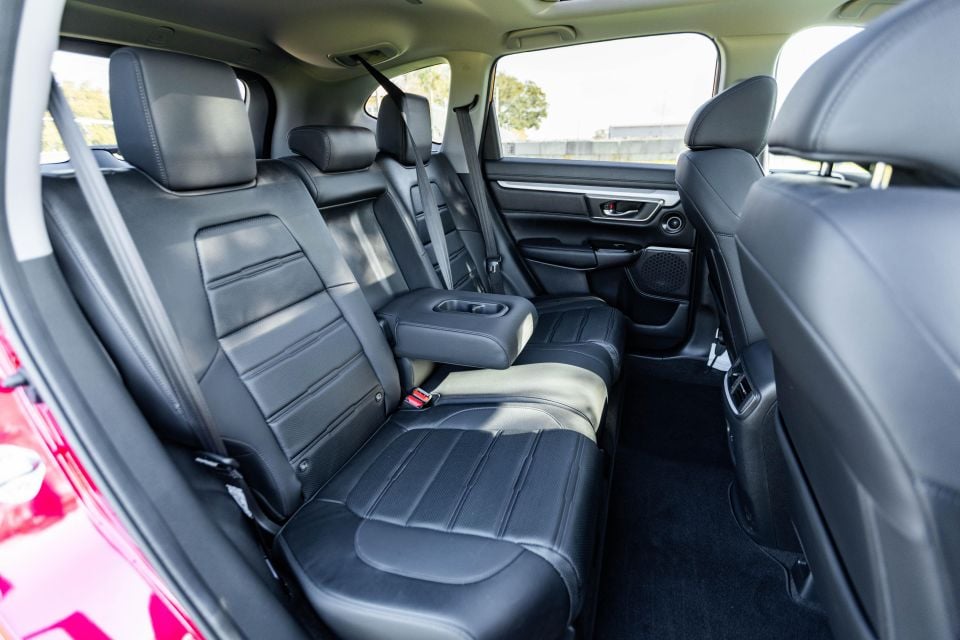
The front seatbacks are upholstered and feature map pockets, while there’s a centre armrest with cupholders. As expected, there are three top-tether and two ISOFIX anchor points for child seats.
The panoramic sunroof doesn’t stretch quite as far back as the second-row seatbacks, though it still lets in plenty of light into the rear of the cabin and gives occupants another view.
The boot is well-sized, and you can drop the second-row seatbacks with the press of a button. There are two little storage nooks on either side of the main boot floor. Our tester also came with a practical rubber accessory cover for the load bay.
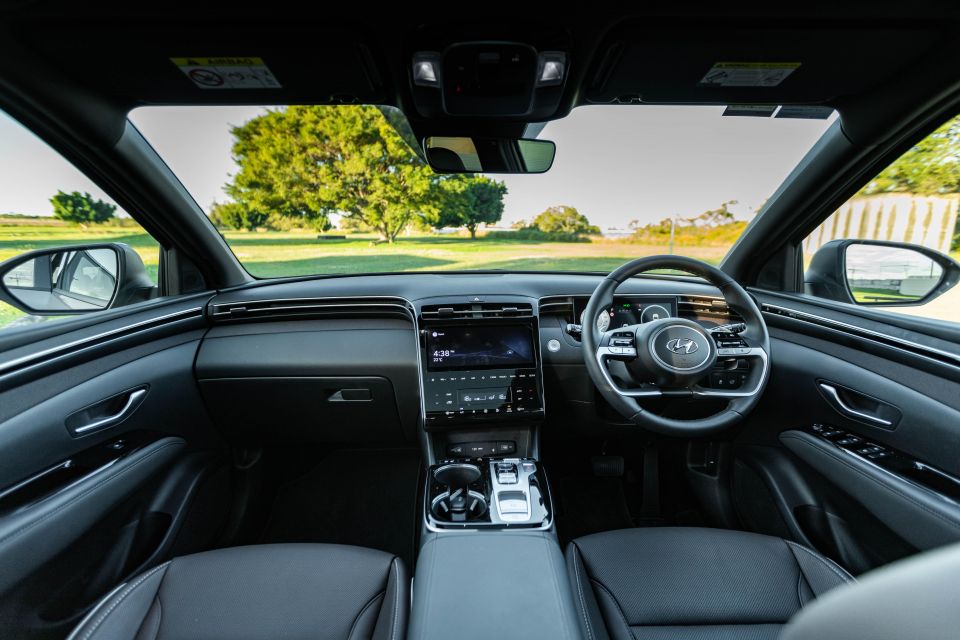
Where expert car reviews meet expert car buying – CarExpert gives you trusted advice, personalised service and real savings on your next new car.
Tucson
The Tucson is the newer vehicle so you’d expect it to have the nicer interior. And oh boy, does it deliver.
Everything from the subtle dual-cowl look to the dashboard to the flush centre stack says elegance in a way the Honda can’t match, with a less busy and more premium look overall.
There are other neat touches, like upholstered inserts on the dash and ambient lighting that changes colour based on your drive mode.
Hyundai has eschewed the du jour tablet-look touchscreen for one neatly integrated into the flowing centre stack. It’s larger than the Honda’s at 10.25 inches diagonally, and boasts much more modern graphics plus features like Sounds of Nature, which allows you to select between a range of ambient soundscapes.
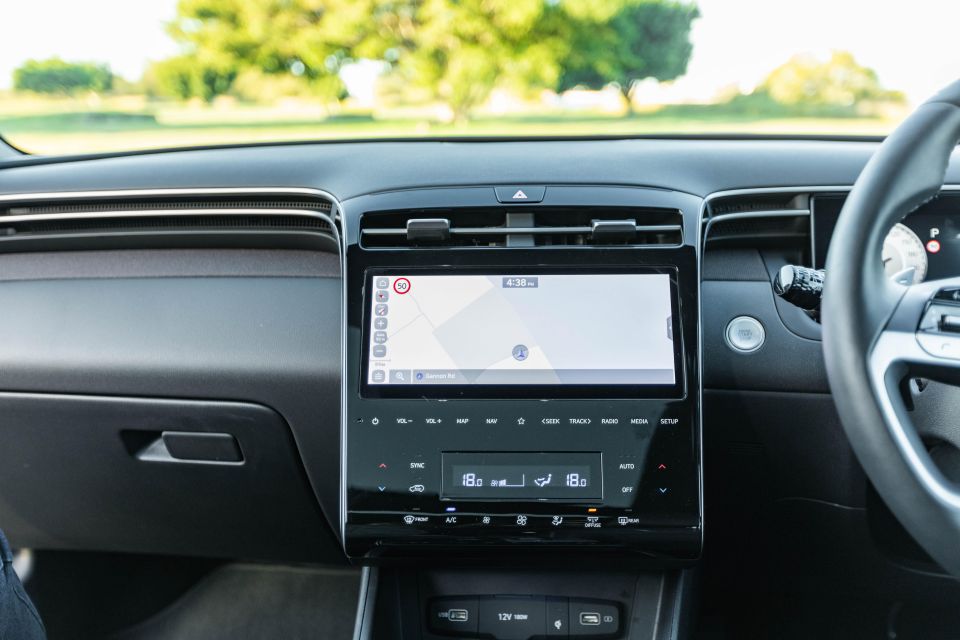
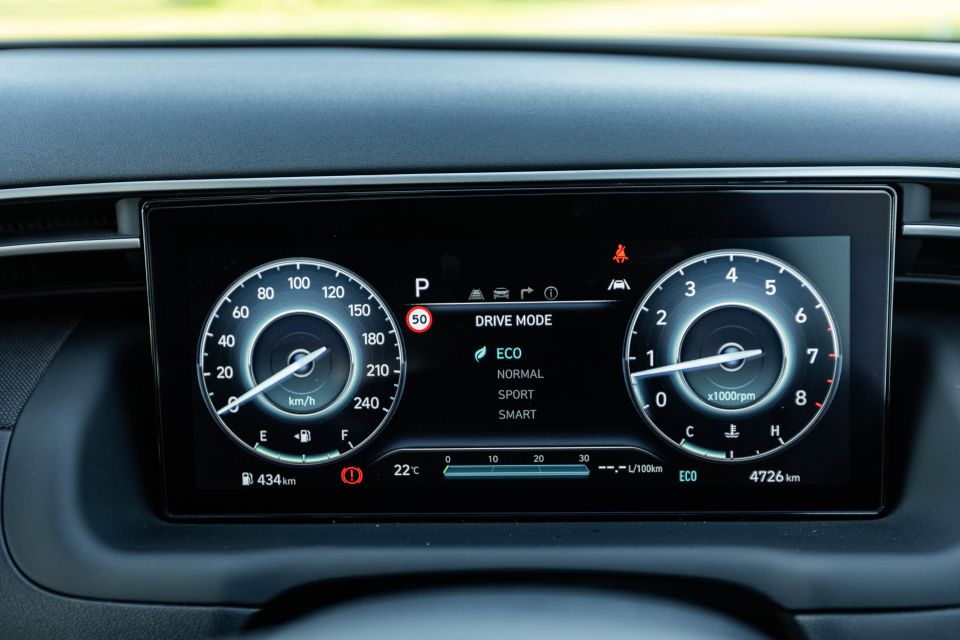
The 10.25-inch digital instrument cluster offers different designs depending on the selected drive mode and is more configurable overall than the CR-V’s digital screen. There’s also the aforementioned Blind-Spot View Monitor.
The steering wheel is rather unusual looking but it feels good in your hands. There’s a voice prompt button on the steering wheel but, unlike in the Honda, this will work only with smartphone mirroring and doesn’t interact at all with the core system.
The clean, unadorned look means there’s an abundance of touch-capacitive controls that disappointingly lack haptic feedback and are finished in smudge-prone piano black. Therefore, while it’ll look lovely in the showroom, you’ll want to keep a microfibre cloth handy as the smudges and dust build up.
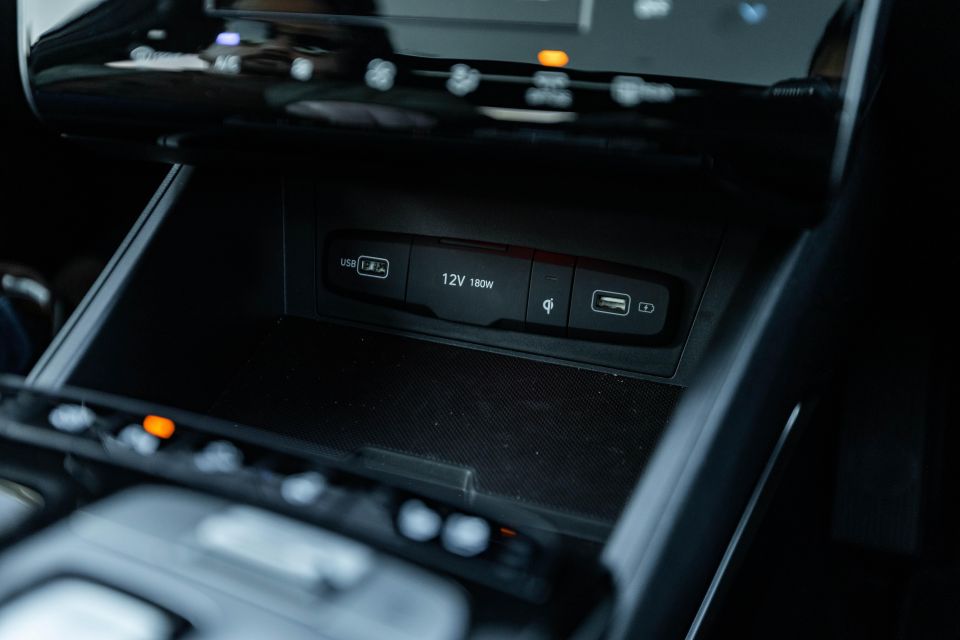

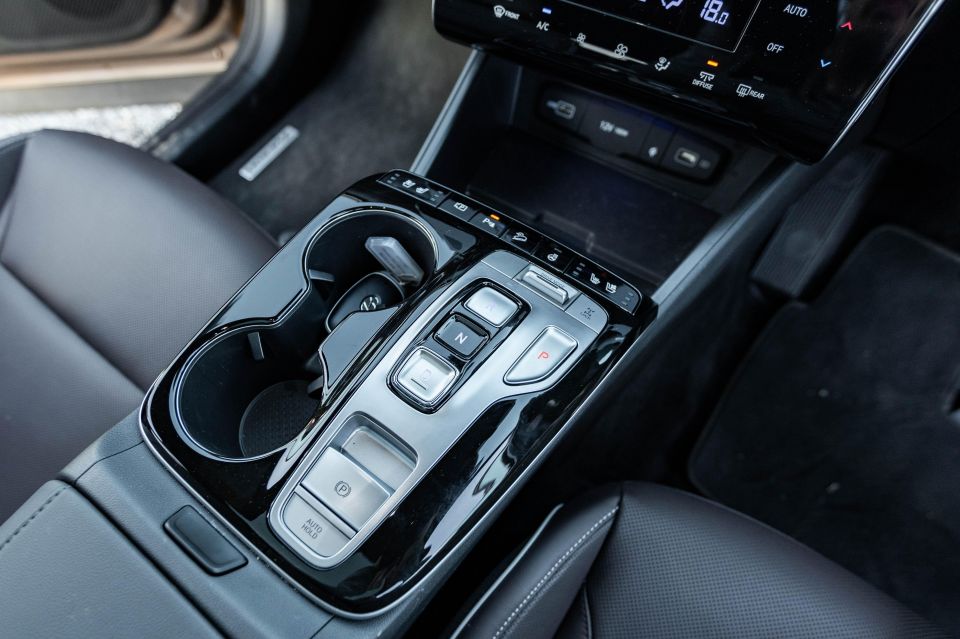
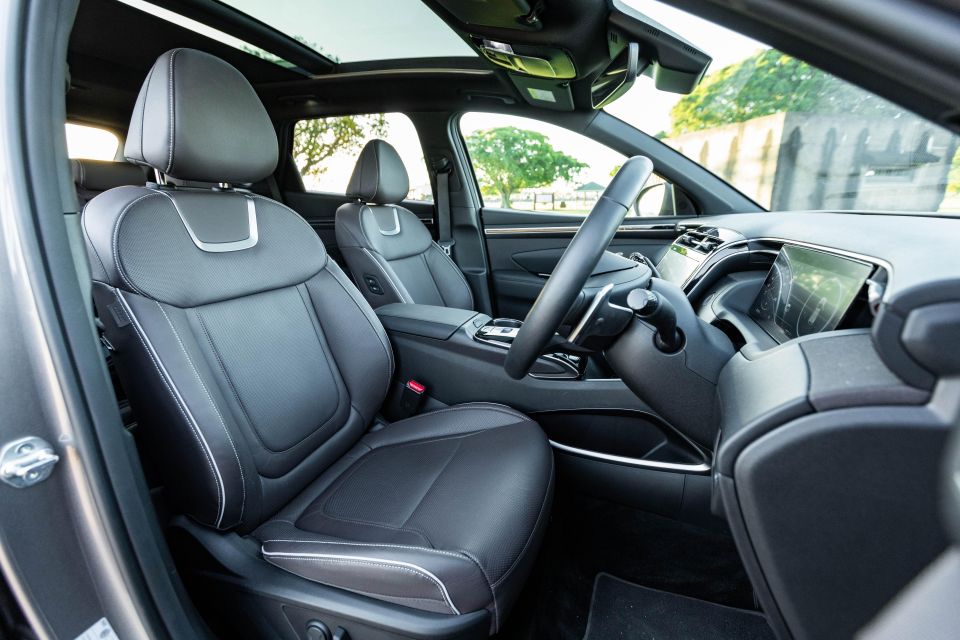
The centre console rises up like a bridge and, while this feels a little confining to sit next to, the Tucson is no less spacious than the CR-V. There’s a centre console bin that’s large if not quite as cavernous as the CR-V’s central storage, while there are also cupholders and a wireless charging pad, 12V outlet and two USB-A ports at the base of the centre stack.
Some of the piano black buttons on the centre console are actual buttons and, while Hyundai has banished hard touch interfacing from the centre stack, it has embraced it for the transmission. This is hardly a new concept – Chrysler was offering a push-button shifter back in the 1950s – but it may take some getting used to. Personally, I prefer to have something to grab onto.
The Tucson’s panoramic sunroof is even more expansive than the CR-V’s, reaching all the way back to the second-row headrests. Like the CR-V’s, it doesn’t noticeably eat into headroom.
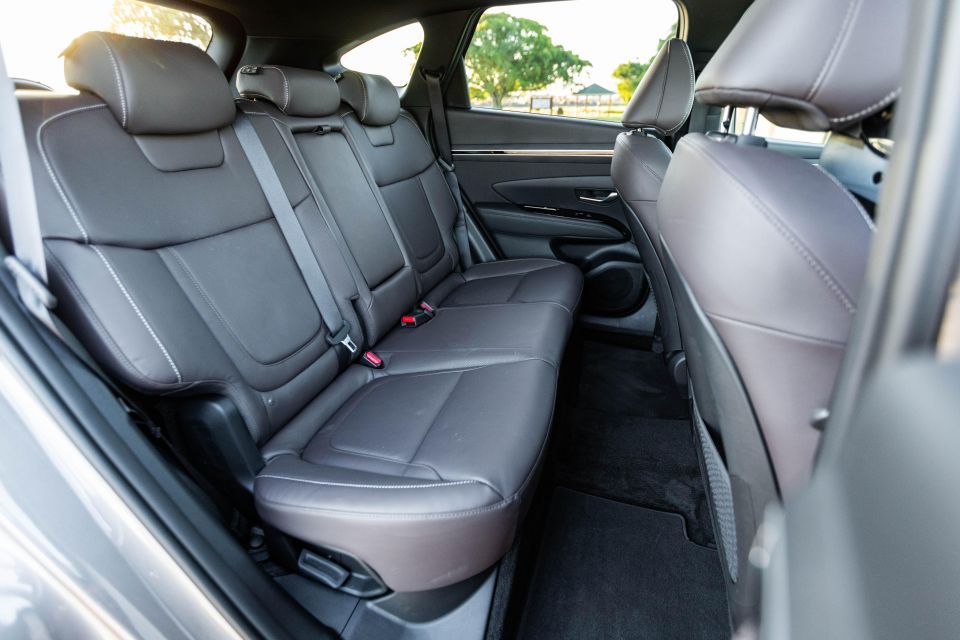
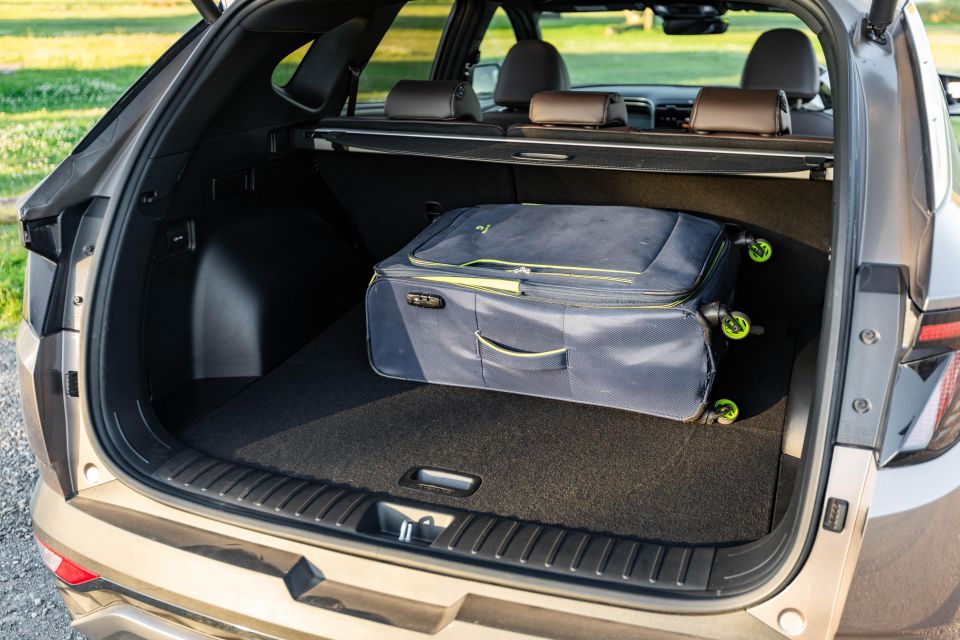
The rear of the cabin is supremely spacious thanks to the longer wheelbase of the latest generation. You’ll find air vents and two USB-A outlets at the rear of the centre console, plus a bottle holder in each door albeit no can holder like in the CR-V. There’s a fold-down centre armrest, plus three top-tether and two ISOFIX anchor points for child seats.
If we have any quibbles, it’s that the armrests sit a bit low and the cloth trim used on the doors could get dirty.
The rear seatbacks can be dropped from the boot with the press of a button, like in the Honda. Unlike the Honda, the Hyundai also features a 12V outlet back here, though the boot floor is flush so there’s no little storage cavities on either side of the main load space as in the CR-V.
| CR-V | Tucson | |
|---|---|---|
| Length | 4635mm | 4630mm |
| Width | 1855mm | 1865mm |
| Height | 1689mm | 1665mm |
| Wheelbase | 2660mm | 2755mm |
| Boot | 522L | 539L |
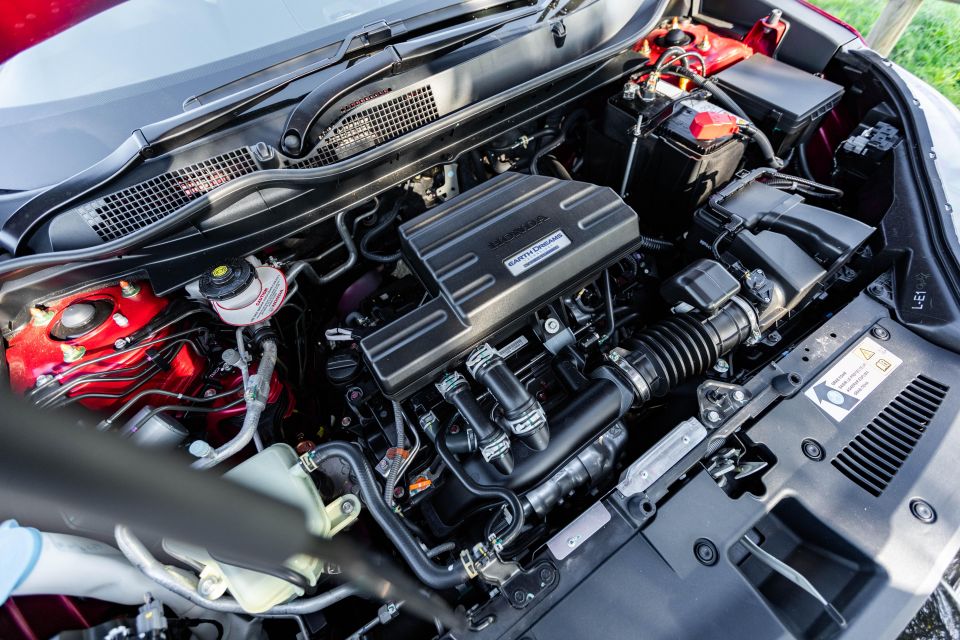
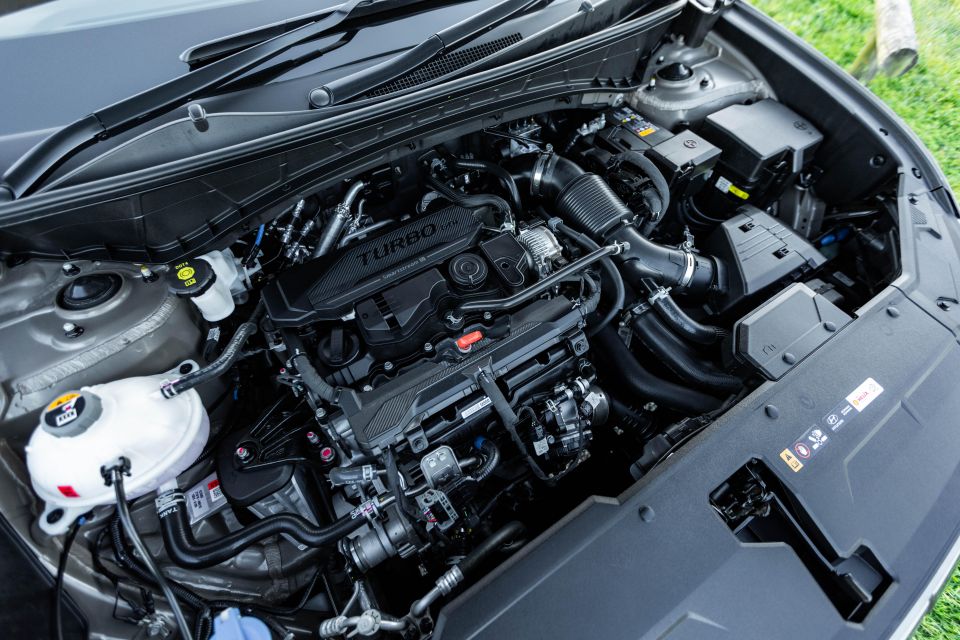
Both vehicles are similar on paper when it comes to what’s under the bonnet.
The CR-V has a turbocharged 1.5-litre four-cylinder engine producing 140kW of power and 240Nm of torque, while the Tucson has a turbocharged 1.6-litre four with 132kW and 265Nm. Both come standard with all-wheel drive.
Where they differ the most is in their transmissions. The CR-V uses a continuously-variable transmission (CVT), while the Tucson has a seven-speed dual-clutch automatic transmission.
Over an identical test loop, comprising inner-city, suburban and highway driving, we averaged 7.7L/100km in the CR-V and 8.6L/100km in the Tucson. Over the course of our time with both vehicles, and with a heavy skew towards urban driving, those figures rose to 10.4L/100km and 11L/100km, respectively.
| CR-V | Tucson | |
|---|---|---|
| Fuel type | 91RON regular unleaded | 91RON regular unleaded |
| Displacement | 1.5-litre | 1.6-litre |
| Induction | Turbocharged | Turbocharged |
| Power | 140kW at 5600rpm | 132kW at 5500rpm |
| Torque | 240Nm at 2000-5000rpm | 265Nm at 1500-4500rpm |
| Transmission | CVT | Seven-speed dual-clutch automatic |
| Drive type | All-wheel drive | All-wheel drive |
| Fuel economy (claimed) | 7.4L/100km | 7.2L/100km |
| Fuel economy (observed) | 7.7L/100km | 8.6L/100km |
| Towing capacity | 1500kg braked | 1650kg braked |
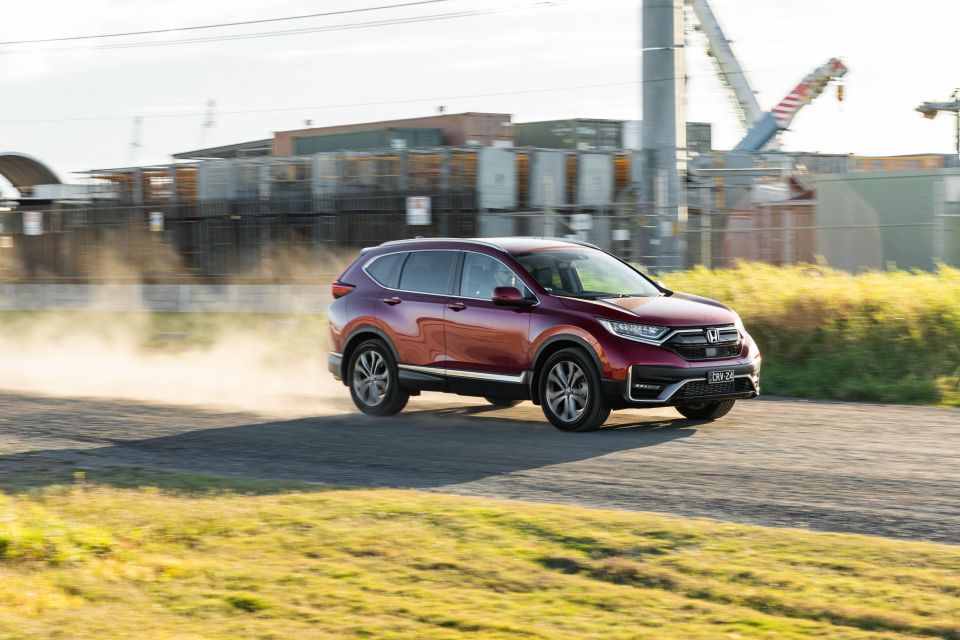
CR-V
A CVT is perfectly acceptable in a mid-sized SUV and the CR-V’s gets the job done. It can drone a bit but it keeps the car in its optimal torque band and you rarely need to rev the CR-V hard.
That’s for the best as, should you rev it, the CR-V can get a bit raucous. Wind noise and tyre roar is fairly subdued, even at highway speeds, while the turbocharger only produces a faint whistle. It’s really just the din of the engine that perturbs should you really push it.
At low revs, however, the CR-V’s CVT is slightly smoother than the Tucson’s DCT. There’s a manual shift mode with seven artificial gears should you wish to exercise more control. The paddle shifters aren’t as nice as those in the Tucson but they feel solid.
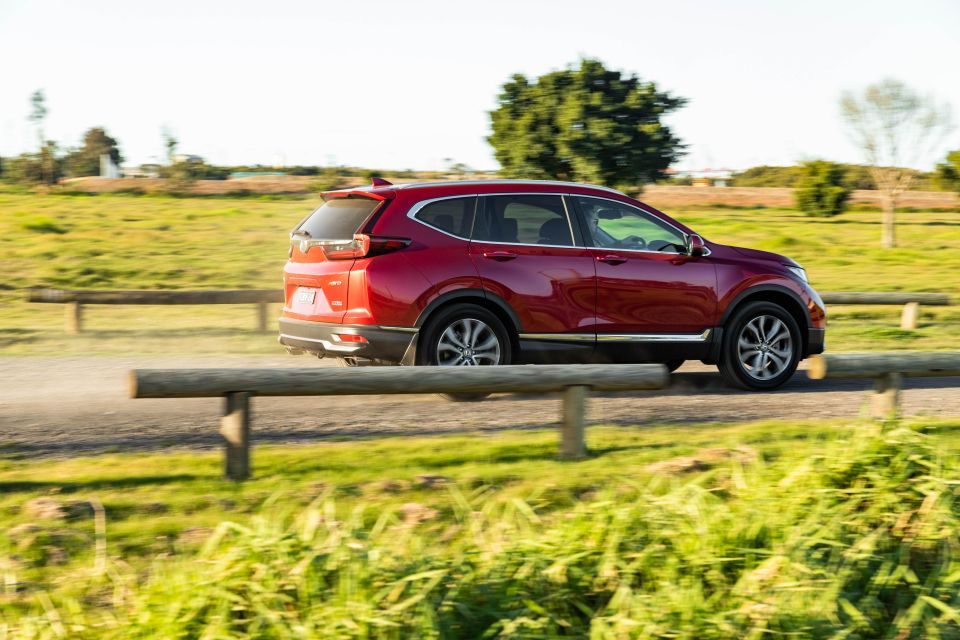
It’s the shifter that’s the problem, as it feels old and low-rent and Sport mode is located below Drive instead of to the side. The latter means you’ll find yourself accidentally selecting it at first.
Ride quality is largely comparable to the Tucson – perhaps a touch firm but always dispatching bumps and ruts with ease and never feeling harsh.
The lane-keep assist works as superbly on the highway as the Hyundai’s lane-following assist. The car stays securely within a lane and the system dominates the steering wheel to the point that you feel it could drive itself.

Setting aside the lane support systems, the CR-V has particularly likeable steering. There’s a good amount of road feel and it’s nicely weighted, inspiring confidence in the CR-V’s abilities.
The all-wheel drive system also feels more proactive than that in the Tucson, and the CR-V feels balanced and stable at all times. There’s a bit of body roll in corners, but that’s par for the course in a mid-sized SUV; the CR-V does seem to corner a bit flatter than the Tucson, though.
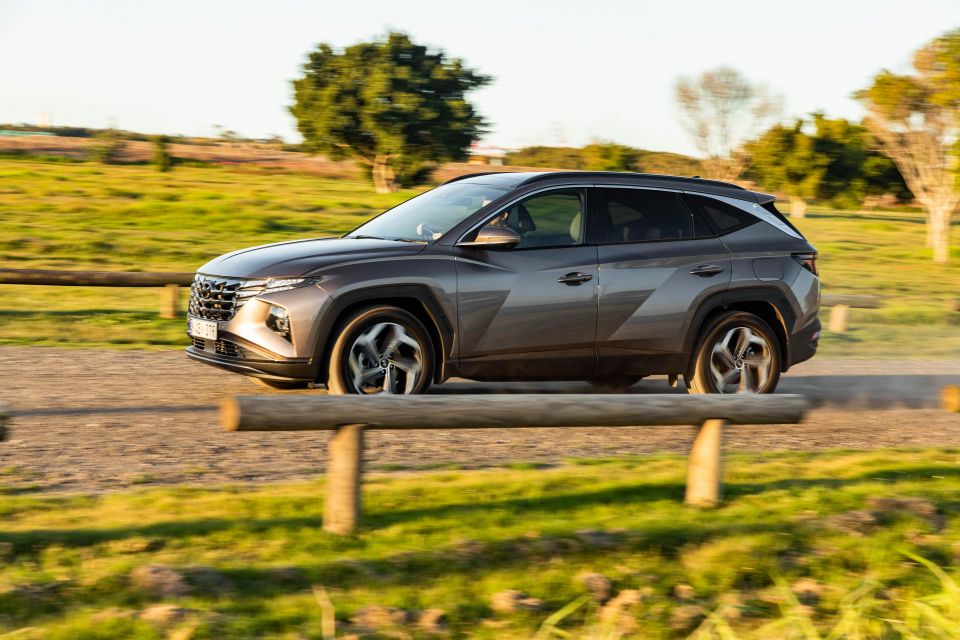
Tucson
The first thing you notice about the Tucson after driving the CR-V is how much quieter it is. Particularly at highway speeds, the Tucson’s cabin is serene, with only faint whispers of wind noise.
The turbocharged four-cylinder also sounds better than some of Hyundai’s other four-bangers, with an engine note that never sounds too strained. It’s a punchy engine and vastly superior to the standard 2.0-litre atmo mill, and it feels more responsive than the CR-V.
That’s no surprise as, though it’s down 8kW, peak torque is up 25Nm on the Honda and comes in earlier (1500rpm vs. 2000rpm).
Much as CVTs have their downsides, so too do DCTs. The Tucson’s, however, is quite good with only a slight hesitation and a slight lack of smoothness at car park speeds.
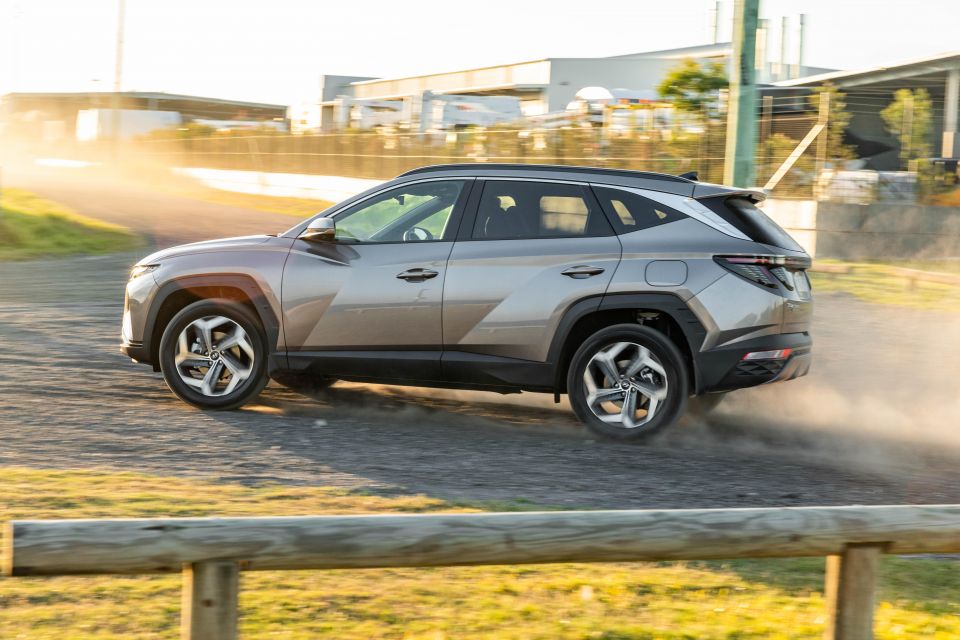
Picking up the pace, there are the wonderfully snappy shifts you would expect from a DCT, and we saw little reason to use the paddle shifters or switch it to sport mode.
Surprisingly for an all-wheel drive vehicle, you’ll encounter some wheelspin at times such as when you’re turning at a junction with an eager right foot. The Tucson’s handling is hard to fault, though, for a mid-sized SUV – it feels secure and comfortable, if never overtly sporty, and the weight shifts predictably in corners.
Likewise, the ride quality is pleasant. The suspension tune is somewhat firm, but you can take the Tucson on particularly nasty, rutted roads and it never loses its composure.
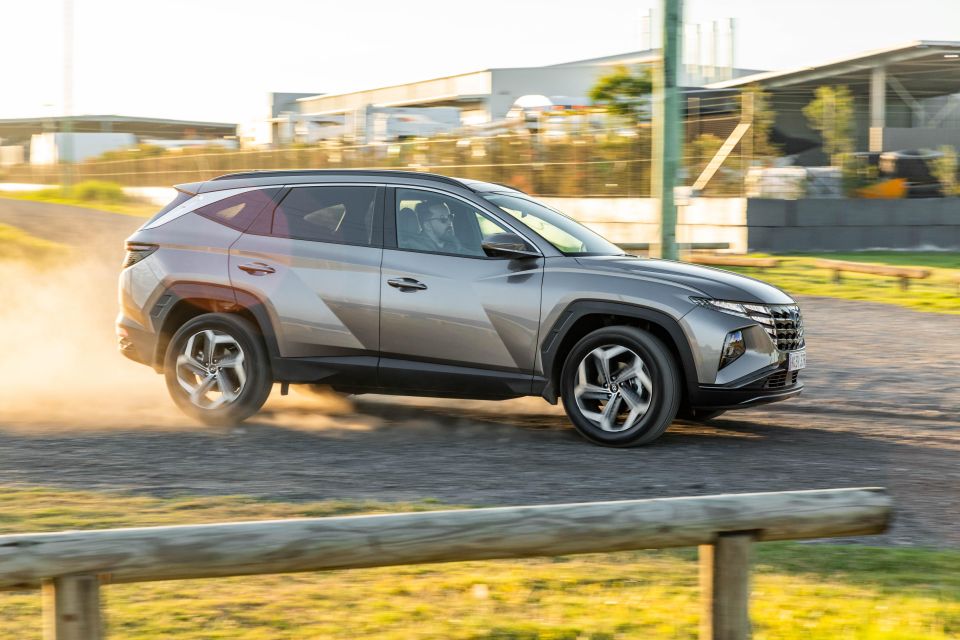
The steering is only slightly lacking in feel compared to the CR-V’s, but the difference is scarcely noticeable.
There’s one downside to the way the Tucson drives, and that’s the brake pedal. It’s spongy and hard to modulate, and really undermines your confidence when you’re on a more challenging road.
| CR-V | Tucson | |
|---|---|---|
| Kerb weight | 1636kg | 1689kg |
| Front suspension | MacPherson strut | MacPherson strut |
| Rear suspension | Multi-link | Multi-link |
| Front brakes | Ventilated disc | Ventilated disc |
| Rear brakes | Solid disc | Solid disc |
| Tyres as tested | Michelin Latitude Sport 3 235/55 R19 | Nexen Roadian GTX 235/55 R19 101H |
| Clearance | 198mm | 181mm |
| Turning circle | 11m | 11.8m |
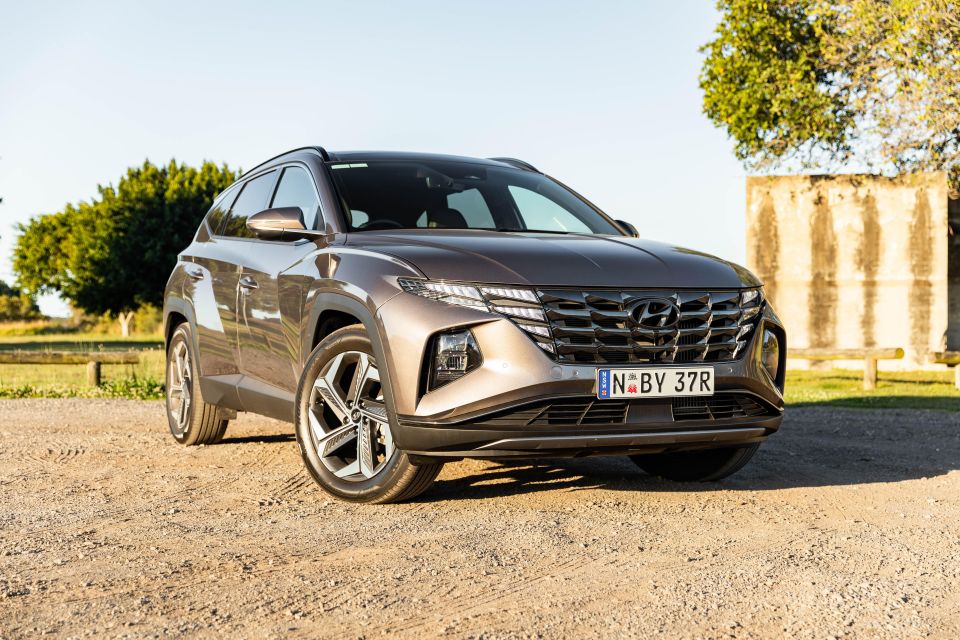

Both vehicles are covered by a five-year, unlimited-kilometre warranty.
As part of its ‘agency’ relaunch, Honda has slashed the cost of its servicing. It offers five years of capped-price servicing, with each visit costing just $125. That means it costs just $625 to service over the first five years, though intervals are a bit short at 12 months or 10,000km.
The Hyundai also requires servicing every 12 months or 10,000km, though with either of its other two engines the intervals are longer at 15,000km. The first five services are capped at $319 each, for a total of $1595.
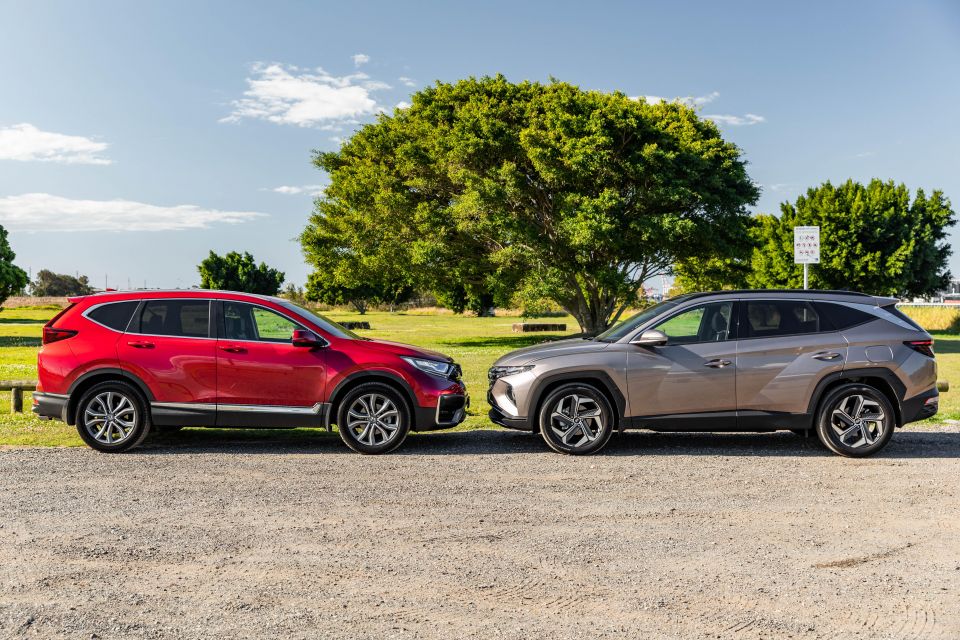
It’s perhaps no surprise the newer, fresher Hyundai Tucson wins this comparison test, but the Honda CR-V still has plenty to offer.
The CR-V feels slightly more engaging to drive than the Tucson, CVT aside, while it undercuts the Tucson on price, is cheaper to service and uses less fuel. It also has a spacious, comfortable and well-made interior plus a long list of standard kit.
Unfortunately for the CR-V, the Tucson also has a roomy interior and offers an even longer list of standard equipment. The extra safety equipment is the biggest boon.
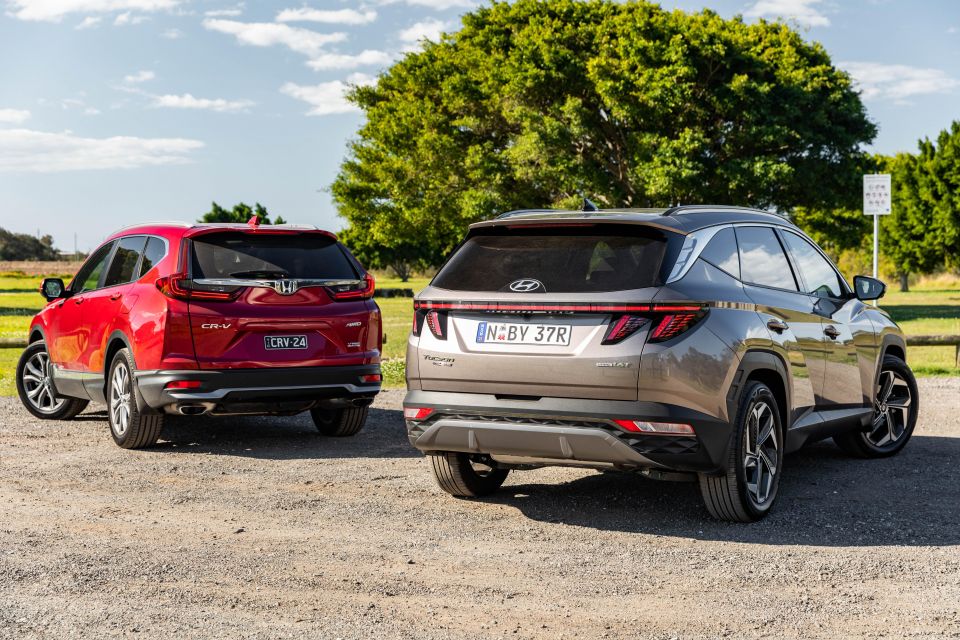
We may lament the rise of touch controls and piano black interior trim, but the Tucson – though profuse with these – nevertheless offers a more visually appealing interior. Likewise, the infotainment feels a good generation or two ahead of the CR-V’s. The exterior styling mightn’t be to everybody’s taste, but it stands out more than the CR-V’s familiar if handsome appearance.
The CR-V’s basic goodness means the Tucson doesn’t trounce it, but it shows progression in enough areas to give it the lead here. With the CR-V nearing the end of its lifecycle, though, Hyundai had better watch out for the next-generation model.
MORE: Everything Honda CR-V MORE: Everything Hyundai Tucson
Share your thoughts with us in the comments below!
William Stopford is an automotive journalist with a passion for mainstream cars, automotive history and overseas auto markets.
Share your thoughts and write a review of a car you own and get featured on CarExpert.


William Stopford
4 Hours Ago


Max Davies
4 Hours Ago


Derek Fung
5 Hours Ago


Matt Campbell
12 Hours Ago


Ben Zachariah
1 Day Ago


Damion Smy
1 Day Ago